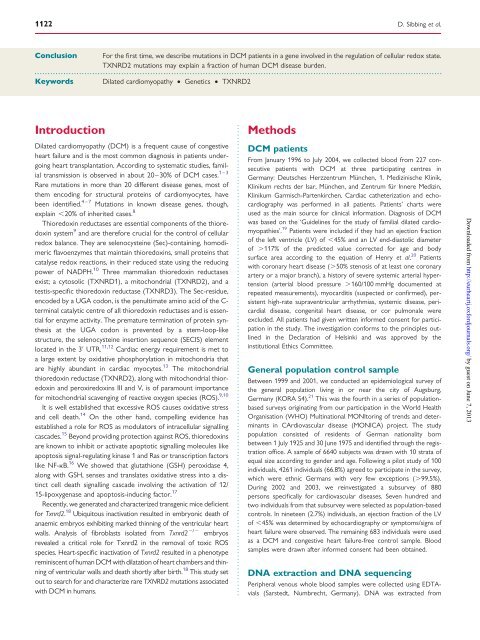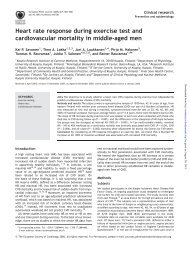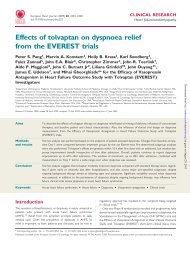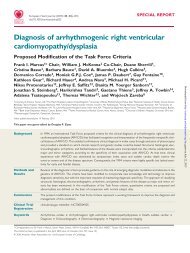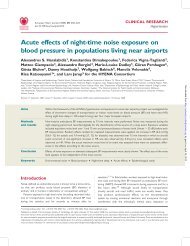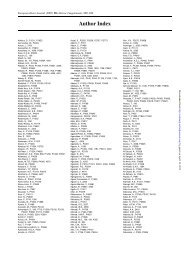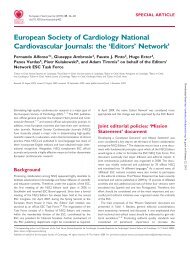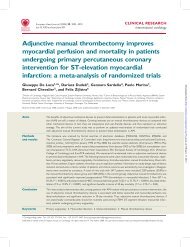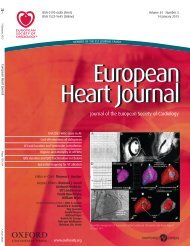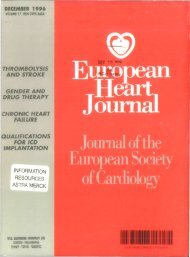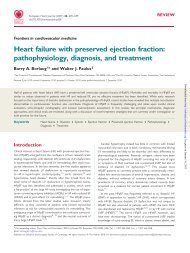Mutations in the mitochondrial thioredoxin reductase gene TXNRD2 ...
Mutations in the mitochondrial thioredoxin reductase gene TXNRD2 ...
Mutations in the mitochondrial thioredoxin reductase gene TXNRD2 ...
You also want an ePaper? Increase the reach of your titles
YUMPU automatically turns print PDFs into web optimized ePapers that Google loves.
1122<br />
Conclusion For <strong>the</strong> first time, we describe mutations <strong>in</strong> DCM patients <strong>in</strong> a <strong>gene</strong> <strong>in</strong>volved <strong>in</strong> <strong>the</strong> regulation of cellular redox state.<br />
<strong>TXNRD2</strong> mutations may expla<strong>in</strong> a fraction of human DCM disease burden.<br />
-----------------------------------------------------------------------------------------------------------------------------------------------------------<br />
Keywords Dilated cardiomyopathy † Genetics † <strong>TXNRD2</strong><br />
Introduction<br />
Dilated cardiomyopathy (DCM) is a frequent cause of congestive<br />
heart failure and is <strong>the</strong> most common diagnosis <strong>in</strong> patients undergo<strong>in</strong>g<br />
heart transplantation. Accord<strong>in</strong>g to systematic studies, famil-<br />
1 – 3<br />
ial transmission is observed <strong>in</strong> about 20–30% of DCM cases.<br />
Rare mutations <strong>in</strong> more than 20 different disease <strong>gene</strong>s, most of<br />
<strong>the</strong>m encod<strong>in</strong>g for structural prote<strong>in</strong>s of cardiomyocytes, have<br />
been identified. 4 – 7 <strong>Mutations</strong> <strong>in</strong> known disease <strong>gene</strong>s, though,<br />
expla<strong>in</strong> ,20% of <strong>in</strong>herited cases. 8<br />
Thioredox<strong>in</strong> <strong>reductase</strong>s are essential components of <strong>the</strong> thioredox<strong>in</strong><br />
system 9 and are <strong>the</strong>refore crucial for <strong>the</strong> control of cellular<br />
redox balance. They are selenocyste<strong>in</strong>e (Sec)-conta<strong>in</strong><strong>in</strong>g, homodimeric<br />
flavoenzymes that ma<strong>in</strong>ta<strong>in</strong> thioredox<strong>in</strong>s, small prote<strong>in</strong>s that<br />
catalyse redox reactions, <strong>in</strong> <strong>the</strong>ir reduced state us<strong>in</strong>g <strong>the</strong> reduc<strong>in</strong>g<br />
power of NADPH. 10 Three mammalian thioredox<strong>in</strong> <strong>reductase</strong>s<br />
exist; a cytosolic (TXNRD1), a <strong>mitochondrial</strong> (<strong>TXNRD2</strong>), and a<br />
testis-specific thioredox<strong>in</strong> <strong>reductase</strong> (TXNRD3). The Sec-residue,<br />
encoded by a UGA codon, is <strong>the</strong> penultimate am<strong>in</strong>o acid of <strong>the</strong> Cterm<strong>in</strong>al<br />
catalytic centre of all thioredox<strong>in</strong> <strong>reductase</strong>s and is essential<br />
for enzyme activity. The premature term<strong>in</strong>ation of prote<strong>in</strong> syn<strong>the</strong>sis<br />
at <strong>the</strong> UGA codon is prevented by a stem-loop-like<br />
structure, <strong>the</strong> selenocyste<strong>in</strong>e <strong>in</strong>sertion sequence (SECIS) element<br />
located <strong>in</strong> <strong>the</strong> 3 ′ UTR. 11,12 Cardiac energy requirement is met to<br />
a large extent by oxidative phosphorylation <strong>in</strong> mitochondria that<br />
are highly abundant <strong>in</strong> cardiac myocytes. 13 The <strong>mitochondrial</strong><br />
thioredox<strong>in</strong> <strong>reductase</strong> (<strong>TXNRD2</strong>), along with <strong>mitochondrial</strong> thioredox<strong>in</strong><br />
and peroxiredox<strong>in</strong>s III and V, is of paramount importance<br />
for <strong>mitochondrial</strong> scaveng<strong>in</strong>g of reactive oxygen species (ROS). 9,10<br />
It is well established that excessive ROS causes oxidative stress<br />
and cell death. 14 On <strong>the</strong> o<strong>the</strong>r hand, compell<strong>in</strong>g evidence has<br />
established a role for ROS as modulators of <strong>in</strong>tracellular signall<strong>in</strong>g<br />
cascades. 15 Beyond provid<strong>in</strong>g protection aga<strong>in</strong>st ROS, thioredox<strong>in</strong>s<br />
are known to <strong>in</strong>hibit or activate apoptotic signall<strong>in</strong>g molecules like<br />
apoptosis signal-regulat<strong>in</strong>g k<strong>in</strong>ase 1 and Ras or transcription factors<br />
like NF-kB. 16 We showed that glutathione (GSH) peroxidase 4,<br />
along with GSH, senses and translates oxidative stress <strong>in</strong>to a dist<strong>in</strong>ct<br />
cell death signall<strong>in</strong>g cascade <strong>in</strong>volv<strong>in</strong>g <strong>the</strong> activation of 12/<br />
15-lipoxygenase and apoptosis-<strong>in</strong>duc<strong>in</strong>g factor. 17<br />
Recently, we <strong>gene</strong>rated and characterized transgenic mice deficient<br />
for Txnrd2. 18 Ubiquitous <strong>in</strong>activation resulted <strong>in</strong> embryonic death of<br />
anaemic embryos exhibit<strong>in</strong>g marked th<strong>in</strong>n<strong>in</strong>g of <strong>the</strong> ventricular heart<br />
walls. Analysis of fibroblasts isolated from Txnrd2 2/2 embryos<br />
revealed a critical role for Txnrd2 <strong>in</strong> <strong>the</strong> removal of toxic ROS<br />
species. Heart-specific <strong>in</strong>activation of Txnrd2 resulted <strong>in</strong> a phenotype<br />
rem<strong>in</strong>iscent of human DCM with dilatation of heart chambers and th<strong>in</strong>n<strong>in</strong>g<br />
of ventricular walls and death shortly after birth. 18 This study set<br />
out to search for and characterize rare <strong>TXNRD2</strong> mutations associated<br />
with DCM <strong>in</strong> humans.<br />
Methods<br />
DCM patients<br />
From January 1996 to July 2004, we collected blood from 227 consecutive<br />
patients with DCM at three participat<strong>in</strong>g centres <strong>in</strong><br />
Germany: Deutsches Herzzentrum München, 1. Mediz<strong>in</strong>ische Kl<strong>in</strong>ik,<br />
Kl<strong>in</strong>ikum rechts der Isar, München, and Zentrum für Innere Mediz<strong>in</strong>,<br />
Kl<strong>in</strong>ikum Garmisch-Partenkirchen. Cardiac ca<strong>the</strong>terization and echocardiography<br />
was performed <strong>in</strong> all patients. Patients’ charts were<br />
used as <strong>the</strong> ma<strong>in</strong> source for cl<strong>in</strong>ical <strong>in</strong>formation. Diagnosis of DCM<br />
was based on <strong>the</strong> ‘Guidel<strong>in</strong>es for <strong>the</strong> study of familial dilated cardiomyopathies’.<br />
19 Patients were <strong>in</strong>cluded if <strong>the</strong>y had an ejection fraction<br />
of <strong>the</strong> left ventricle (LV) of ,45% and an LV end-diastolic diameter<br />
of .117% of <strong>the</strong> predicted value corrected for age and body<br />
surface area accord<strong>in</strong>g to <strong>the</strong> equation of Henry et al. 20 Patients<br />
with coronary heart disease (.50% stenosis of at least one coronary<br />
artery or a major branch), a history of severe systemic arterial hypertension<br />
(arterial blood pressure .160/100 mmHg documented at<br />
repeated measurements), myocarditis (suspected or confirmed), persistent<br />
high-rate supraventricular arrhythmias, systemic disease, pericardial<br />
disease, congenital heart disease, or cor pulmonale were<br />
excluded. All patients had given written <strong>in</strong>formed consent for participation<br />
<strong>in</strong> <strong>the</strong> study. The <strong>in</strong>vestigation conforms to <strong>the</strong> pr<strong>in</strong>ciples outl<strong>in</strong>ed<br />
<strong>in</strong> <strong>the</strong> Declaration of Hels<strong>in</strong>ki and was approved by <strong>the</strong><br />
<strong>in</strong>stitutional Ethics Committee.<br />
General population control sample<br />
D. Sibb<strong>in</strong>g et al.<br />
Between 1999 and 2001, we conducted an epidemiological survey of<br />
<strong>the</strong> <strong>gene</strong>ral population liv<strong>in</strong>g <strong>in</strong> or near <strong>the</strong> city of Augsburg,<br />
Germany (KORA S4). 21 This was <strong>the</strong> fourth <strong>in</strong> a series of populationbased<br />
surveys orig<strong>in</strong>at<strong>in</strong>g from our participation <strong>in</strong> <strong>the</strong> World Health<br />
Organisation (WHO) Mult<strong>in</strong>ational MONItor<strong>in</strong>g of trends and determ<strong>in</strong>ants<br />
<strong>in</strong> CArdiovascular disease (MONICA) project. The study<br />
population consisted of residents of German nationality born<br />
between 1 July 1925 and 30 June 1975 and identified through <strong>the</strong> registration<br />
office. A sample of 6640 subjects was drawn with 10 strata of<br />
equal size accord<strong>in</strong>g to gender and age. Follow<strong>in</strong>g a pilot study of 100<br />
<strong>in</strong>dividuals, 4261 <strong>in</strong>dividuals (66.8%) agreed to participate <strong>in</strong> <strong>the</strong> survey,<br />
which were ethnic Germans with very few exceptions (.99.5%).<br />
Dur<strong>in</strong>g 2002 and 2003, we re<strong>in</strong>vestigated a subsurvey of 880<br />
persons specifically for cardiovascular diseases. Seven hundred and<br />
two <strong>in</strong>dividuals from that subsurvey were selected as population-based<br />
controls. In n<strong>in</strong>eteen (2.7%) <strong>in</strong>dividuals, an ejection fraction of <strong>the</strong> LV<br />
of ,45% was determ<strong>in</strong>ed by echocardiography or symptoms/signs of<br />
heart failure were observed. The rema<strong>in</strong><strong>in</strong>g 683 <strong>in</strong>dividuals were used<br />
as a DCM and congestive heart failure-free control sample. Blood<br />
samples were drawn after <strong>in</strong>formed consent had been obta<strong>in</strong>ed.<br />
DNA extraction and DNA sequenc<strong>in</strong>g<br />
Peripheral venous whole blood samples were collected us<strong>in</strong>g EDTAvials<br />
(Sarstedt, Numbrecht, Germany). DNA was extracted from<br />
Downloaded from<br />
http://eurheartj.oxfordjournals.org/ by guest on June 7, 2013


